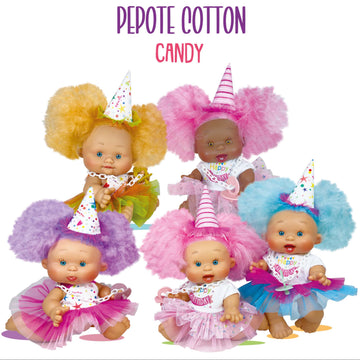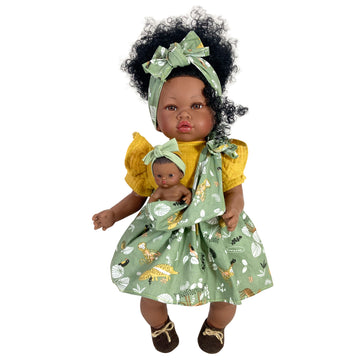Excitement About Dolls And Accessories
Excitement About Dolls And Accessories
Blog Article
Get This Report about Dolls And Accessories
Table of ContentsDolls And Accessories Fundamentals ExplainedThe Only Guide for Dolls And AccessoriesSome Known Details About Dolls And Accessories A Biased View of Dolls And AccessoriesAbout Dolls And AccessoriesWhat Does Dolls And Accessories Do?Indicators on Dolls And Accessories You Need To Know
When dolls are included in group play, youngsters practice waiting, sharing, and listening to others' ideas. Whether they're claiming to be a parent, sibling, or friend, children learn just how partnerships workhow to sustain others, fix disagreements, and take care of somebody else. These very early role-play experiences end up being the groundwork for healthy and balanced relationships and partnerships later on in life.Repeating comforting regimens with a doll (feeding, rocking, putting to bed) can assist children really feel tranquil and safe. These calming routines teach them how to self-regulate. Caring for a doll can make a kid really feel qualified and positive - european dolls. It offers them a sense of obligation and control in a world that typically feels uncertain.
Dolls And Accessories Can Be Fun For Everyone
When children see dolls that show their race, heritage, and culture, it enhances a favorable feeling of identity. Dolls likewise present children to cultures outside their own, constructing considerate curiosity and compassion for others.
As Dr. Karyn Purvis, a leader in child advancement and trauma-informed care, once stated: This powerful quote highlights how play isn't just funit's exactly how kids discover finest. The brain cords itself via rep. Yet when a child is engaged, cheerful, and psychologically connected to an activitylike doll playthe mind strengthens those connections faster and much more meaningfully.
The Only Guide for Dolls And Accessories

Boys need compassion, generosity, and creative imagination tooand doll play provides that. Yesdolls supply something distinct. They motivate open-ended storytelling and emotional connection in a manner few other toys do. Dolls are frequently a youngster's first "pal," aiding them exercise connections, construct communication skills, and feel comforted. Kids establish their sense of self from a young age.
The smart Trick of Dolls And Accessories That Nobody is Talking About
Through play. Through pride. With dolls that matter. Thanks for joining us on this journey. Samantha Ong Samantha Ong is the creator of Joeydolls, a Canadian-based plaything brand on an objective to celebrate Asian cultures with joyful, inclusive play. Influenced by her own experiences maturing without cultural depiction, Samantha creates dolls that help kids feel happy with who they are while sparking inquisitiveness and empathy in others.
Having fun with dolls motivates kids to speak more regarding others' thoughts and emotions, a research has discovered. The research suggests that playing fictional games with dolls could help kids establish social abilities, concept of mind and compassion. The neuroscientist who led the hop over to these guys job said that the academic value of having fun with Lego and building toys was commonly approved, yet the benefits of playing with dolls in some cases showed up to have actually been overlooked."When kids develop fictional worlds and duty have fun with dolls, they communicate initially aloud and after that internalise the message concerning others' thoughts, feelings and feelings," claimed Dr Sarah Gerson, a neuroscientist at Cardiff College and the lead writer.
The Dolls And Accessories Statements
They were also most likely to resolve the dolls in the 2nd person, speaking to them straight, whereas the characters on the computer system display they had a tendency to refer to in the 3rd person. No distinction was observed between young boys and girls."Inner state language can suggest that a kid is considering various other people's ideas and emotions while having fun with dolls," stated Gerson.
And that they see language usage in this regard is good verification of the theory."Mardell added that the searchings for ought to use to any kind of role-play plaything, instead than being specific to Barbies."Children usually begin to show signs of interior state language around the age of 4.
Dolls And Accessories Fundamentals Explained
"It becomes vital for making and maintaining relationships, and just how they gain from their instructors, and parents."The research study also discovered that the kids had actually increased brain activity in the posterior remarkable temporal sulcus (pSTS) area when they spoke as though their dolls had ideas and sensations. The pSTS area is believed to be entailed in the growth of social and emotional processing abilities.
Childhood years is not a static life stage; certainly, the interpretation, significance and understanding of childhood years are all subject to modification. By the nineteenth century one of one of the most extensive modifications was the value put on allowing youngsters to experience "the care free pleasures" of youth through playtime tasks. Play was currently taken into consideration to be an important component of a great childhood.
In order to totally recognize the definition of play, one need to also understand the importance of the doll. Dolls are a lot even more than playthings designed to amuse young women. During the 19th century correct playtime tasks were chosen to advertise intellectual, physical or psychological development. Dolls were specifically popular due to the fact that they were believed to cultivate and nurture womanly high qualities such as compassion, caring and empathy.
The Dolls And Accessories PDFs

It is just with archaeological investigations that researchers can wish to uncover and record the full series of playtime experiences. Narrating these experiences, and specifically the function of dolls, is critical for presenting a much more full photo of youth during the 19th century. Alarcn, Sara E - dolls., "Kid's Play: The Duty of Dolls in 19th Century Childhood Years" (2007 )
Report this page